Have you ever cooked brisket or wondered what part of the cow it comes from? Brisket is one of the most popular cuts of beef, and it’s one that’s been popular for centuries. It’s not only used in traditional slow-cooked dishes like barbecue and corned beef, but it’s also used in deli sandwiches, tacos, and even in some salads. But what part of the cow is brisket? This blog will share the best brisket recipe for the perfect smoked meat experience.
Introduction to Brisket
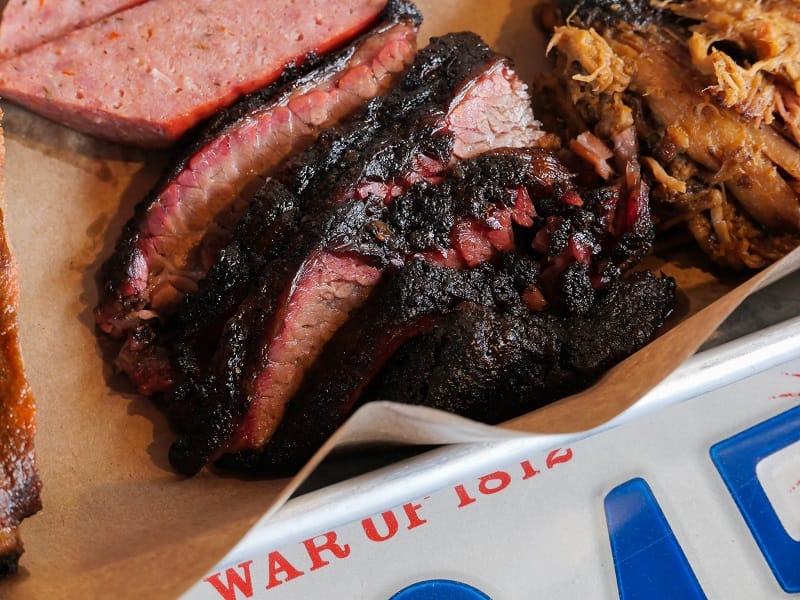
Brisket is a popular cut of beef for smoking and barbecuing, as it is a flavorful piece of meat that is relatively inexpensive. It is also a favorite for pot roasts and other slow-cooked dishes.
One of the best things about brisket is that it is so versatile. It can be used for sandwiches, tacos, stews, pot roasts, and more. It is also very forgiving, so even if you overcook it, it will still be tender and flavorful.
Brisket is an excellent choice if you’re looking for a delicious, mouth-watering cut of meat to prepare for a special occasion or just for a weekend barbecue. The unique flavor of brisket is a result of its low and slow cooking process, which helps to tenderize the meat and bring out the best flavor. While brisket is a favorite of barbecuers and slow cookers alike, it’s also an incredibly versatile cut of meat that can be used in various dishes.
No matter how you prepare it, brisket is sure to make a delicious and flavorful dish that will please everyone at the table. Whether you’re looking for a special dish to serve on a special occasion or just a flavorful and juicy cut of meat for your weekend barbecue, brisket is an excellent choice.
The Benefits of Brisket
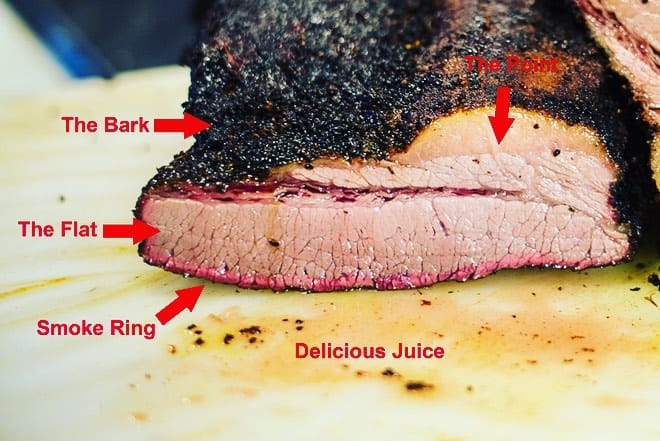
Brisket is considered one of the tougher cuts of beef, but its low cost and full flavor make it a great choice for various dishes. This cut of beef is a favorite among many barbecue chefs, and here are some of the benefits of brisket that make it so popular.
- Tenderness: Brisket is a tougher cut of beef, but with proper cooking, it can be incredibly tender. Low and slow cooking methods such as smoking, braising, or slow roasting will result in a perfectly tender cut of meat.
- Full Flavor: Brisket has a lot of flavors because it contains more intramuscular fat than other cuts of beef. This fat is what adds flavor and moisture to the brisket.
- Low Cost: Brisket is one of the cheaper cuts of beef, making it a popular choice for those on a budget. It is also suitable for large gatherings, as it can feed many people.
- Versatility: Brisket can be cooked in various ways, from braising to smoking to barbecuing. This makes it an excellent choice for those who want to experiment with different cooking methods.
- Leftovers: Brisket is great for leftovers – it can be used in sandwiches, salads, tacos, and more! The flavor of the brisket only improves after it has been cooked, so don’t be afraid to cook extra for future meals.
- Slow cooking: Brisket is best when cooked slowly over low heat for several hours. This allows the flavors of the beef to concentrate and the fat to render. When cooked this way, the brisket will be incredibly tender and juicy.
- Nutritious: Brisket is a lean beef cut and an excellent protein source. It is also a good source of iron, zinc, and B vitamins.
Brisket is an excellent choice for those who want a flavorful, budget-friendly cut of beef. With its full flavor, low cost, and versatility, brisket is an ideal beef cut for various dishes.
What Part Of The Cow Is Brisket?
The brisket is a cut of meat that comes from the chest or breast area of the cow, located between the shoulder and the ribcage. It is a triangular cut taken from the breast or lower chest of the animal and is composed of both superficial and deep pectoral muscles. It contains a lot of fat and connective tissue, which needs to be simmered to ensure a tender, juicy end result. The whole brisket comprises two parts, the point, and the flat, which are thicker and fattier than the flat.
What Is The Taste And Texture Of Brisket?
Brisket tastes different from region to region, with Oklahoma preferring heavy rubs on black pepper and garlic powder, while Memphis prefers paprika-heavy dry rubs. Brisket is a tough cut of meat located in the breast or lower chest area that can be cooked for hours without drying out, making it an excellent choice for a large gathering.
When cooked correctly, brisket is tender and flavorful due to its significant fat content that renders out into the meat. Cooking brisket is extensive and can take between four and twelve hours to get the meat tender enough. The texture of properly cooked brisket is probe tender and still juicy. The taste of the brisket depends on the region and the type of rub used.
What Are The Differences Between A Beef Brisket And A Pork Brisket?
Beef brisket is more popular and relatively larger than pork brisket. Pork brisket, on the other hand, is a cut of meat found on a pig’s pectoral muscles and obtained by removing the hog’s upper picnic ham. Pork brisket comprises two parts, a lean end like the flat obtained from the pork belly and a fat section like the point obtained from the picnic shoulder.
Beef brisket is more expensive than pork, with a price about three times that of pork. Both cuts of meat have a lot of connective tissue, making them ideal for smoking; however, smoking pork is easier than beef brisket.
Is Brisket A Lean Or Fatty Cut Of Meat?
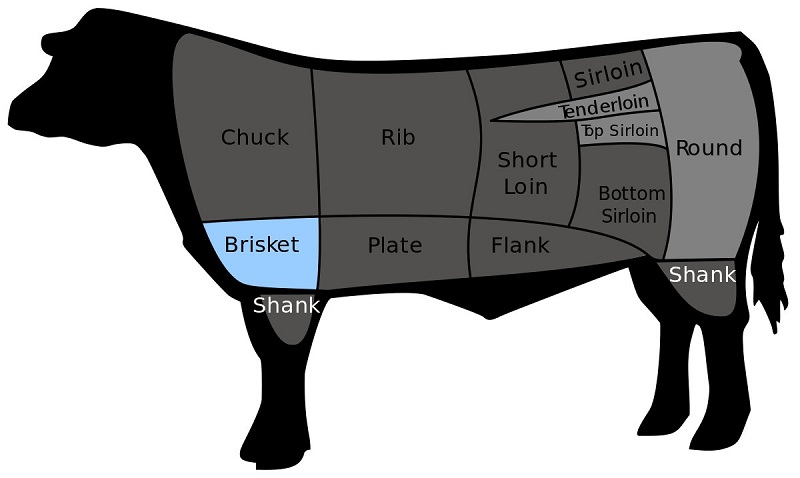
Brisket is a type of meat composed of the point and the flat muscles. The point muscle, which sits on top, has more intermuscular fat or marbling that makes it fattier, while the rectangular flat below it is denser and leaner.
Lean cuts tend to be found on supermarket shelves and have their fats trimmed away, but it’s best if you cook them slowly to avoid drying them out. On the other hand, moist brisket cuts are juicier and more flavorful due to their high-fat content, making them an excellent choice for barbeque enthusiasts.
Is Brisket A Fatty Cut Of Meat?
Yes, brisket is a fatty cut of meat. It contains a high percentage of intramuscular fat called ‘marbling,’ which gives it a richer flavor. The point end of the brisket is typically fattier than the flat end. It has a fat cap on one side that should be cut off after cooking. The fat melts as the brisket is smoked, adding flavor to the meat. The flat cut makes up most of the brisket and has a thick layer of fat on top that helps keep it moist. While leaner cuts of beef are available, brisket is still relatively high in fat content compared to other cuts.
See more:
- Smoking Brisket At 250 Vs 225
- How Many Ribeyes In A Cow
- Can You Overcook Brisket
- How To Keep Brisket Warm
How is Brisket Cut?
Cooking brisket is a great way to enjoy a delicious and hearty meal, but getting the cuts right can be tricky. Knowing how to cut brisket properly is the key to ensuring your dish turns out perfect every time.
So, how is brisket cut? First, the brisket must be trimmed out of fat, as it will shrink during cooking. Next, the brisket should be cut across the meat’s grain, cutting it into thin slices at a slight angle. This is important as it helps to break down the tough muscle fibers, making the meat easier to chew.
To ensure you’re cutting the brisket correctly, look at the direction of the grain. The meat’s grain should appear like a series of thin lines running across the meat in one direction. Once you have identified the grain, you’ll want to slice the brisket against the grain, making sure each slice is about 1/4 inch thick.
When cutting the brisket, it is best to do so while the meat is still cold. This ensures that the fat is more solid and easier to cut through. The first place to cut is at the intersection of the flat and the point muscles. This way, you can separate the two cuts of the brisket. Once separated, the flat cut can be sliced with a sharp knife against the grain into thin slices. The point cut can also be sliced against the grain into smaller pieces or left whole for later use.
After slicing brisket, the cooking time and heat must be kept in mind. If the brisket is cooked at too high of a heat, it can dry out and become tough. On the other hand, if the cooking time is too long, the brisket may become too tender and fall apart. To ensure that your brisket turns out perfectly cooked, use a thermometer and cook until it reaches an internal temperature of 185°F.
Once your brisket is cooked to perfection, let it rest before serving. This will help to evenly distribute the juices and make your dish even more delicious.
How to Choose Beef Brisket?
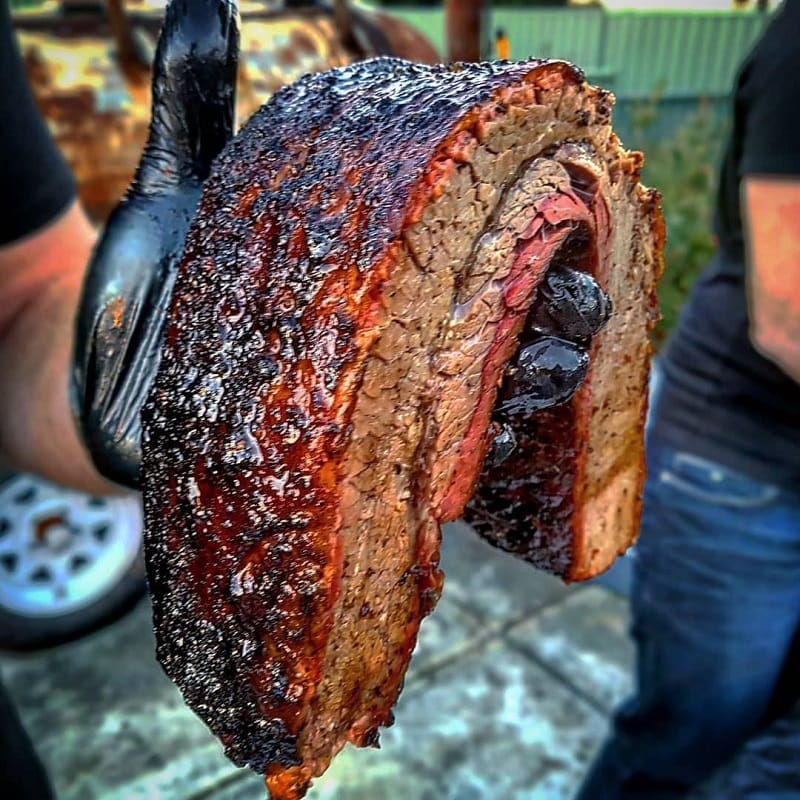
When selecting the proper brisket, it’s important to consider the fat content, the size of the cut, and the type of beef. Here’s what you should know when choosing the perfect beef brisket.
Fat Content
The fat content of the brisket is an essential factor in determining the flavor and texture. Briskets can range from 0-20% fat. A higher fat content will give the brisket more taste, making it juicier and more tender. A lower fat content will create a more lean and more firm cut of beef.
A higher fat content is recommended for juicier results if you cook for a crowd. However, a lower fat content is recommended if you cook for a smaller group and look for a leaner cut.
Size of the Cut
The size of the cut will also affect the time it takes to cook the brisket. A larger cut of beef will take longer to cook than a smaller cut. When selecting a brisket, consider the size of the cut and the number of people you will serve.
Type of Beef
When selecting a brisket, it is important to consider the type of beef. The most common types of beef used for brisket are Angus, Hereford, and Wagyu. Angus is the most common and is usually the least expensive of the three. Hereford is known for its exceptional marbling and flavor and is typically more expensive. Wagyu is considered the crème de la crème of beef, and is the most expensive.
How to Slice Brisket the Right Way?
- First, you’ll want to make sure you have the right tools. Investing in a good-quality slicing knife is essential. It should be sharp and long enough to reach across the entire brisket. You can use a sharp chef’s knife if you don’t have a slicing knife.
- Second, the brisket should be cooked thoroughly before you begin slicing. Brisket should be cooked low and slow, so it can be cooked for up to 10 hours. Once it’s cooked, let it rest for at least 30 minutes.
- Third, you’ll want to slice the brisket against the grain. The grain refers to the muscle fibers that run through the meat. To slice against the grain, you’ll want to cut the brisket into thin slices at a 45-degree angle.
- When cutting a brisket, you need to know the difference between the flat and the point. The flat is the larger, thinner piece of beef and the point is the thicker, fattier portion. It’s important to separate the flat and point before slicing since the point will be much easier to slice. Once you have the flat and point separated, the next step is to trim the fat. Remove any excess fat on the flat and point. Trimming the fat will help the brisket cook more evenly, resulting in a juicy and tender finished dish.
- Finally, you’ll want to serve the brisket right away. Serve the brisket as soon as it’s sliced. If you wait too long, the brisket can dry out and lose its flavor.
Are There Any Special Techniques For Making The Most Tender And Juicy Brisket?
Now that we have answered the question of what part of the cow is brisket, there are specific techniques for making the most tender and juicy brisket:
- Firstly, when applying a rub, it is best to be generous. This helps create the dark crust, or bark, on the brisket during the cooking process.
- Secondly, slicing the brisket against the grain is crucial for achieving a tender piece of meat. Slice the brisket with a sharp carving knife to the desired thickness.
- Thirdly, wrapping the brisket in bacon is an optional technique that adds extra fat and flavor to the meat.
- Fourthly, when cooking the brisket in the oven, it is important first to pat it dry, season it with salt and pepper, and sear it on both sides.
- Lastly, pour some of the cooking juices into any remaining sauce and use to baste the brisket when broiling (grilling) in a preheated oven. For the best quality brisket, it is recommended to purchase a Choice or Prime grade, which will have more marbling (fat).
Ways to Cook Brisket
Smoker
If you’re an experienced BBQ master, you likely already know the secret to a perfectly cooked brisket – low and slow in the smoker. To create that fall-apart flavor and texture, start by rubbing the brisket with a dry rub of your choice, and then let it sit in the fridge overnight to soak up all that tasty flavor. Then, cook the brisket in the smoker and let it smoke for at least eight hours or until it reaches an internal temperature of at least 165°F. Once the brisket is cooked, let it rest for at least 30 minutes before slicing.
Oven
If you don’t have a smoker, don’t worry – you can still create the same rich flavor in the oven. Simply rub the brisket with a dry rub of your choice and let it sit in the fridge overnight. Then, preheat the oven to 325°F and place the brisket in a roasting pan. Add a cup of beef broth or stock to the pan, and then cover the pan with a lid or aluminum foil. Cook the brisket in the oven for 3-4 hours or until it reaches an internal temperature of at least 165°F. Let the brisket rest for at least 30 minutes before slicing.
Sous Vide
Try cooking it the sous vide way for an even more tender and juicy brisket. Start by rubbing the brisket with a dry rub of your choice, and let it sit in the fridge overnight. Then, preheat your sous vide bath to 165°F and place the brisket in a large Ziploc bag. Seal the bag, making sure to leave some air in the bag, and then place the bag in the sous vide bath. Cook the brisket in the sous vide bath for at least 24 to 36 hours at 155°F or 36 to 72 hours at 135°F. Once the brisket is cooked, remove it from the bag and let it rest for at least 30 minutes before slicing.
How To Cook The Perfect Brisket
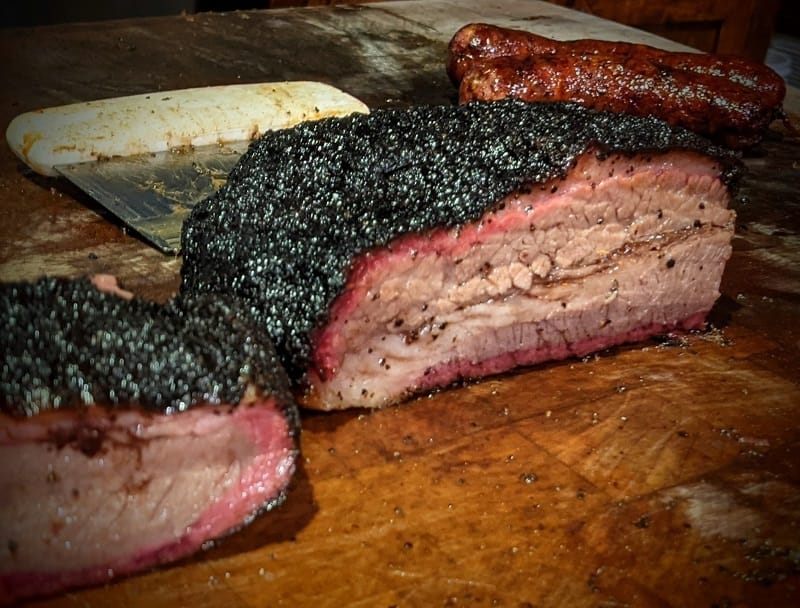
When it comes to cooking brisket, the key is to take your time and not rush it. Start by selecting the right cut of meat. Look for a brisket with a nice, thick fat layer for tenderness and flavor.
Once you’ve got the right cut, it’s time to prepare the brisket. First, season the brisket with salt, pepper, and your favorite herbs and spices. This will help create a flavorful outside crust while also tenderizing the meat. To cook the perfect brisket, one should trim the fat to a 1/4-inch thickness. After this is done, the brisket should be marinated overnight (12 to 24 hours), allowing the flavors to develop fully.
Next, it’s time to cook the brisket. There are a few methods to choose from, depending on your preference. Place the pan in the oven and bake for about 1 hour and 15 minutes per pound until the brisket reaches an internal temperature of 180°F.
To add more smokiness to the brisket, Greg Blonder suggests spritzing it with water, beef broth, or apple juice before cooking. To add a smoky flavor, arrange medium-hot coals around a drip pan and place the brisket on the smoker. Cook until the internal temperature reaches 170°F, which should take about an hour and a half per pound.
Finally, close the lid on the smoker and continue cooking at 225 degrees F until the brisket’s internal temperature reaches 202 degrees F in the thickest part. Generally, plan for 60 minutes for every pound of smoked brisket, including the rest or hold temperature, when cooking at 250 degrees Fahrenheit. Following these steps will ensure that your brisket is cooked perfectly.
Once the brisket is cooked, it’s time to slice and serve. Slice the brisket against the grain and enjoy your perfectly cooked brisket. For an even better experience, add a hint of BBQ sauce or your favorite spices to give it an extra kick of flavor.
Cooking the perfect brisket takes time and patience, but with the proper technique and preparation, you can easily create a delicious and tender brisket that will be the star of your next dinner gathering. So, go ahead, get cooking, and enjoy the perfect brisket!
Common Mistakes To Avoid When Cooking Brisket
One of the biggest mistakes many make when cooking brisket is choosing the wrong cut. A brisket should be cut from the lower chest area of the cow, where the meat is tougher but more flavorful. If you’re using a pre-packaged brisket cut, make sure it’s labeled as such.
Another common mistake when cooking brisket is not trimming the fat properly. Trimming the fat is essential to prevent the brisket from becoming too greasy. Make sure to get rid of any excess fat and leave only the thin layer that adds flavor and moisture to the meat.
Overcooking is another common mistake that people make when preparing brisket. The ideal internal temperature for cooked brisket is between 190-205°F. To ensure the brisket is cooked perfectly, use a digital thermometer to check the internal temperature of the meat. Good brisket takes time. Smoking too quickly will ruin the texture and flavor of the brisket. When smoking, it’s important to keep the smoke thin and blue and not billow out thick, black smoke.
One of the most important mistakes to avoid when cooking brisket is not allowing it to rest after cooking. Brisket needs to rest after cooking to allow the juices to re-distribute and the meat to become more tender. If you cut into the brisket too soon, the delicious juices will run out, resulting in a dry and tough end product.
Finally, don’t forget to season the brisket properly. Brisket benefits from a good amount of seasoning, such as salt, pepper, garlic powder, and other spices. Season the meat before cooking to ensure the flavors are evenly distributed.
How to Know When Your Brisket is Done?
The probe test is the preferred method for most pitmasters. Insert an instant-read thermometer into the thickest part of the brisket. Your brisket is done when the thermometer reads between 190-200 degrees Fahrenheit.
The fork test is more of a subjective method. Take a fork and insert it into the thickest part of the brisket. If it slides in like butter, your brisket is likely done. If there is some resistance, it probably needs a few more minutes of cook time.
When the probe or fork test tells you that your brisket is done, the next step is to let the brisket rest for at least an hour. This will allow the juices to redistribute and the fat and collagen to melt, making your brisket wonderfully tender.
Serving Suggestions For Beef Brisket
Here are some suggestions for beef brisket that’ll make your next meal special.
- Slow Cooker: A slow cooker is easy to cook beef brisket. You can set it and forget it, allowing you to walk away and attend to other tasks while the beef is cooking. The slow cooker seals in the juices, giving you perfectly cooked and tender beef every time.
- Barbecue: Barbecuing beef brisket is another great way to prepare it. The smoky flavor of charcoal or wood adds to the taste of the beef, creating a delicious main dish. You can slow-cook the beef in a smoker or grill it for a faster option.
- Soups and Stews: Beef brisket can be added to soups and stews for an extra protein boost. It adds a depth of flavor and is a great way to use leftovers.
- Sandwiches and Tacos: For a quick and easy meal, beef brisket makes a great sandwich or taco filling. Choose your favorite toppings and enjoy a meal that’s both hearty and satisfying.
- Fajitas and Burritos: Fajitas and burritos are the perfect way to use leftover beef brisket. Simply combine the beef, peppers, onions, and other toppings of your choice for a south-of-the-border flair.
- Salads: For a light and healthy option, top a salad with slices of cooked beef brisket. The beef adds heartiness and flavor, making a salad a satisfying meal.
How to Store Brisket?
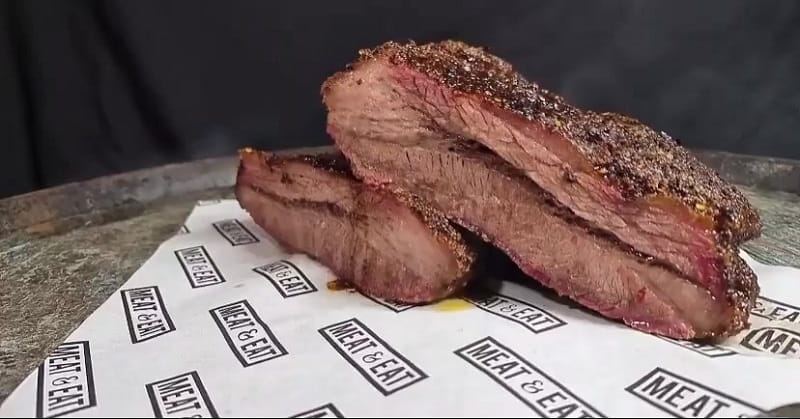
Whether you’re planning to cook your brisket right away or store it for later, the key to preserving its quality is proper preparation and storage. Here are a few tips to help you keep your brisket properly:
- Trim the Fat: It’s important to trim the fat before storing your brisket to reduce the chances of spoilage. Trim off any excess fat, including any fat around the edges. This will help to keep your brisket fresh and flavorful.
- Wrap it Properly: Wrap your brisket carefully in either butcher paper or plastic wrap. This will help to keep the flavor and moisture in your brisket. Be sure to wrap the brisket tightly so no air can get in or out.
- Place in the Refrigerator: Place your wrapped brisket in the refrigerator. This will help to keep it fresh and flavorful. If you’re planning on storing your brisket for more than a few days, it’s best to hold it in the refrigerator.
- Use an Air-Tight Container: If you’re planning to store your brisket for an extended period of time, it’s important to use an air-tight container. This will help to keep the flavor and moisture in your brisket.
- Freeze it: If you’re not going to use your brisket immediately, it’s also a good idea to freeze it. This will help to preserve the flavor and texture of the brisket. Be sure to wrap it tightly and store it in a freezer-safe container.
FAQs About What Part Of The Cow Is Brisket
What is Brisket Called at the Grocery Store?
The grocery store usually labels brisket as “flat cut” or “flat half.” This cut is taken from the lower chest area of a cow and consists of a single muscle. It is usually found in a cryovac package in the meat aisle or behind the butcher counter. Most whole briskets will be cut into two pieces, with the first cut being the most popular and referred to as the flat cut. If you’ve ever had a pastrami or corned beef, you’ve eaten brisket.
Why Is Brisket So Popular?
Brisket’s popularity is due to its low cost and ability to be cooked in various ways. It has been a staple in Jewish culture since the 1600s and has been used as the foundation for corned beef. Brisket is also famous in Texas, where it has been smoked to perfection, making it juicy and tender. Brisket is also inherently kosher, as it has a high-fat content. With its versatility and affordability, it is no wonder why brisket has become a popular dish among many cultures.
How Much Does Brisket Cost?
The brisket cost can vary greatly depending on the quality, store, and location. Generally, brisket will cost between $4 and $14 per pound, but it can be as low as $2 or as high as $22 per pound. Trimmed brisket will be more expensive than untrimmed. Restaurants typically charge between $25 and $35 per pound for brisket. Costco sells brisket for around $9.99 to $16.99 per pound, while Swift Fresh Beef Whole Brisket Boneless is available for between $12.30 and $22.96 per pound. The brisket cost has been increasing in recent years, making it more expensive than it used to be.
Do I Need To Marinate Beef Brisket?
Yes, beef brisket should be marinated before preparation. Marinating helps to tenderize the meat and infuse it with flavor. It is possible to use either a wet or a dry marinade. Wet marinades often contain oil, acid, and a variety of seasonings. Dry rubs are made up of herbs and spices. Examples of suitable marinades include pineapple juice or apple cider vinegar with a can of Coca-Cola for sweetness. There is no need to marinate the brisket overnight, although this will give it more flavor. Before marinating, it is important to ensure all ingredients are combined. After marinating, the brisket can be cooked in the oven, in a slow cooker, or on a pellet grill for the best results.
Is Brisket The Best Part Of A Cow?
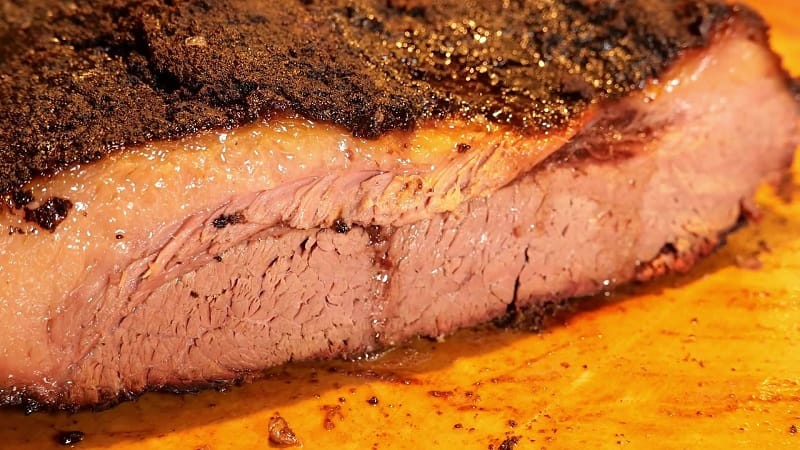
The brisket is considered one of a cow’s best parts. It comes from the chest area, specifically between the shoulder and the first five ribs. It is a tough cut of meat but also full of flavor. When cooked properly, it can be incredibly tender and juicy. The brisket has plenty of fat and connective tissue, which adds flavor and texture. It is a popular cut of meat for barbecuing, braising, and slow-cooking. With its intense flavor and versatility, it’s no wonder that brisket is considered one of the best parts of a cow.
Is Chuck The Same As Brisket?
No, chuck roast and brisket are not the same. Chuck roast is taken from the shoulder of the cow and contains less fat than brisket. It has more connective tissue and is composed of several different muscles. Brisket, on the other hand, is taken from the pectoral region of the animal and is less muscular than chuck.
The fat and muscle are interspersed in brisket, resulting in a juicier and more tender texture when smoked. Chuck roast has a more forward beefy flavor than brisket, making it a good option for those looking for a more traditional beef flavor. The cooking method of each cut also plays an important role in their taste and texture. Chuck roast is best suited for slow cooking or smoking, while brisket can be ready more quickly.
How Long Does Beef Brisket Last?
Cooked beef brisket can last up to four days in the refrigerator if stored properly. It is important to keep the refrigerator’s temperature below 40 degrees Fahrenheit to ensure food safety. Additionally, freezing the brisket will extend its shelf life indefinitely. To ensure that the brisket is stored safely, consuming it within 3-5 days of purchasing or cooking is recommended.
How Many Briskets Per Person?
On average, you should calculate about half a pound of beef brisket per adult for a standard portion. Half a pound of raw brisket yields 1/4 pound of cooked brisket for smaller portions. However, the amount of brisket needed per person could range from 1/4 to 3/4 pounds of cooked brisket, depending on factors such as the type of cut, the size of the portion, and the guests’ appetite. Barbeque aficionados recommend a larger portion of 1 pound of raw brisket per person. When cooking for children, 1/4 pound of cooked brisket per person is generally enough.
Are There Variations Between Different Types Of Briskets?
Yes, there are variations between different types of briskets. Beef, pork, and lamb are the three main types of brisket. Each type has different grades, determined by the amount of fat and connective tissue. The grades are Prime, Choice, and Select from highest to lowest. The beef brisket has two components – point (or deckle) and flat. The point cut is thicker, smaller, and marbled with more fat and connective tissue than the flat cut. Therefore, it has more flavor. Additionally, parts of the beef brisket are lean, flat, and fattier point. The Select grade is the second-lowest grade and has the least fat, making it readily available at grocery stores.
Does Cooking Time Affect The Flavor And Texture Of A Brisket?
Yes, cooking time can affect the flavor and texture of brisket. In general, the longer the brisket is cooked, the more tender it will become. This is due to collagen breaking down as the brisket is cooked. Smoking is a popular cooking method for brisket, as it adds flavor and helps to tenderize the meat. Additionally, brisket can be wrapped in foil partway through the cooking time to reduce the cooking time significantly. However, this may cause the bark to become soggy and give a pot-roast texture. The flavor and texture of brisket will also vary depending on the meat’s breed, age, and quality.
What Are Some Popular Marinades Or Rubs For Making A Flavorful, Succulent Brisket Dish?
Popular marinades and rubs for making a flavorful, succulent brisket dish often consist of garlic, olive oil, paprika, salt, and pepper. A rub or marinade can also include coarse salt, black pepper, smoked paprika, chili powder, onion powder, garlic powder, brown sugar, and mustard powder.
For a marinade, acid-based liquids such as lemon juice, lime juice, vinegar, or any other acid-based marinade can tenderize the brisket. For rubs, onion and garlic powder are staples that should be included to bring out the flavor. Other ingredients such as soy sauce, hot sauce, honey, barbecue sauce, and red pepper can impart flavor and create an Asian or Southwestern taste.
How Can You Tell When Your Brisket Is Cooked Properly Without Overcooking It Or Drying It Out?
The best way to tell when your brisket is cooked properly without over- or undercooking it is to use a probe thermometer. The probe should slide easily into the meat, and the internal temperature should be above 210°F. Additionally, the brisket should be tender enough to quickly melt in your mouth, with a robust beef flavor. If you want to ensure that your brisket does not dry out, you can wrap it in butcher paper or aluminum foil before cooking. This will help to retain moisture and ensure that the meat cooks evenly. Lastly, ensure that you season it properly before cooking to ensure enough fat content and flavor.
Conclusion
So, the next time you’re cooking up a delicious meal, don’t forget to include a flavorful and tender brisket in the meal. Whether you’re slow-cooking or grilling, the brisket is sure to be a hit with everyone. And knowing what part of the cow it comes from will make you look like a certified foodie!
I hope this was helpful! If you have any other questions about what part of the cow is brisket, feel free to leave them in the comments below.

Hey readers! Chip Holland here, and I’m a Manager of this website. My passion for writing about it only matches my passion for BBQ. Follow my blog for mouth-watering recipes, tips, and tricks for the perfect smoke, grill, and BBQ. I’m sure you won’t be disappointed!
